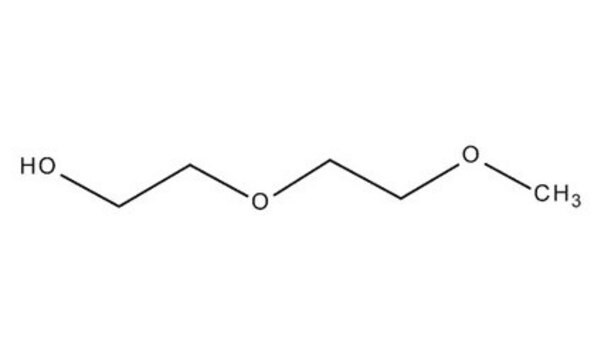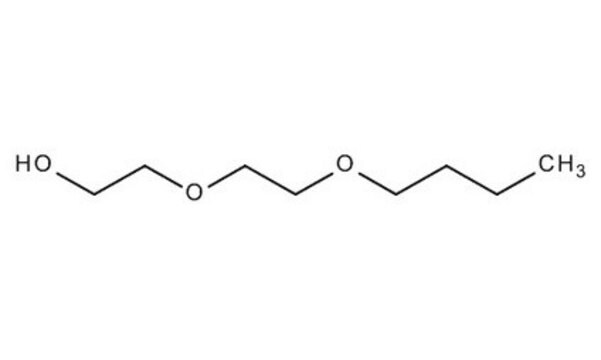8.03127
Diethylene glycol monoethyl ether
for synthesis
Sinónimos:
Diethylene glycol monoethyl ether, Carbitol, 2-(2-Ethoxyethoxy)-ethanol, Ethyl diglycol
About This Item
Productos recomendados
grado
for synthesis
synthesis grade
Nivel de calidad
presión de vapor
0.13 hPa ( 20 °C)
Ensayo
≥98% (GC)
Formulario
liquid
temp. de autoignición
204 °C
potencia
5900-6100 mg/kg LD50, oral (Rat)
8476 mg/kg LD50, skin (Rabbit)
lim. expl.
1.8-12.2 % (v/v)
dilution
(for synthesis)
bp
202 °C/1013 hPa
mp
-78 °C
temperatura de transición
flash point 94 °C
densidad
0.99 g/cm3 at 20 °C
temp. de almacenamiento
2-30°C
cadena SMILES
O(CCOCC)CCO
InChI
1S/C6H14O3/c1-2-8-5-6-9-4-3-7/h7H,2-6H2,1H3
Clave InChI
XXJWXESWEXIICW-UHFFFAOYSA-N
Aplicación
- Investigation of piroctone olamine delivery to the skin from single, binary and ternary solvent systems: This study explores the efficacy of diethylene glycol monoethyl ether as a solvent in dermatological applications, highlighting its role in enhancing skin absorption properties, which is crucial for cosmetic and pharmaceutical formulations (Tang CF, et al., 2023).
- Review of Pharmaceutical Applications of Diethylene Glycol Monoethyl Ether: This review comprehensively covers the pharmaceutical applications of diethylene glycol monoethyl ether, focusing on its solvent properties and roles in drug delivery systems, crucial for advancing drug formulation techniques (Hashemzadeh N, Jouyban A, 2022).
- Stepwise Access of Emissive Ir(III) Complexes Bearing a Multi-Dentate Heteroaromatic Chelate: Demonstrates the application of diethylene glycol monoethyl ether in the synthesis of luminescent materials, providing valuable insights for the development of optical and electronic devices in material science (Zheng Z, et al., 2022).
Nota de análisis
Density (d 20 °C/ 4 °C): 0.987 - 0.990
Water (K. F.): ≤ 0.20 %
Peroxide (as H₂O₂): ≤ 0.05 %
Identity (IR): passes test
Código de clase de almacenamiento
10 - Combustible liquids
Clase de riesgo para el agua (WGK)
WGK 1
Punto de inflamabilidad (°F)
204.8 °F - closed cup
Punto de inflamabilidad (°C)
96 °C - closed cup
Certificados de análisis (COA)
Busque Certificados de análisis (COA) introduciendo el número de lote del producto. Los números de lote se encuentran en la etiqueta del producto después de las palabras «Lot» o «Batch»
¿Ya tiene este producto?
Encuentre la documentación para los productos que ha comprado recientemente en la Biblioteca de documentos.
Los clientes también vieron
Nuestro equipo de científicos tiene experiencia en todas las áreas de investigación: Ciencias de la vida, Ciencia de los materiales, Síntesis química, Cromatografía, Analítica y muchas otras.
Póngase en contacto con el Servicio técnico





